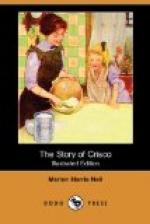Domestic Science teachers recommend Crisco to their pupils and use it in their classes and lecture demonstrations. Many High Schools having Domestic Science departments use Crisco.
Crisco has taken the place of butter and lard in a number of hospitals, where purity and digestibility are of vital importance.
[Illustration: Hospital Dietetic Class]
Crisco is Kosher. Rabbi Margolies of New York, said that the Hebrew Race had been waiting 4,000 years for Crisco. It conforms to the strict Dietary Laws of the Jews. It is what is known in the Hebrew language as a “parava,” or neutral fat. Crisco can be used with both “milchig” and “fleichig” (milk and flesh) foods. Special Kosher packages, bearing the seals of Rabbi Margolies of New York, and Rabbi Lifsitz of Cincinnati, are sold the Jewish trade. But all Crisco is Kosher and all of the same purity.
[Illustration: The Kosher Seal]
Campers find Crisco helpful in many ways. Hot climates have little effect upon its wholesomeness.
It is convenient; a handy package to pack and does not melt so quickly in transit. One can of Crisco can be used to fry fish, eggs, potatoes and to make hot biscuit, merely by straining out the food particles after each frying and pouring the Crisco back into the can to harden to proper consistency before the biscuit making.
[Illustration]
Practically every grocer who has a good trade in Crisco, uses it in his own home.
Crisco is sold by net weight. You pay only for the Crisco—not the can. Find the net weight of what you have been using.
Bread and cake keep fresh and moist much longer when Crisco is used.
[Illustration]
Women have written that they use empty Crisco tins for canning vegetables and fruits, and as receptacles for kitchen and pantry use.
Crisco’s Manufacture Scientifically Explained
To understand something of the Crisco Process, it is necessary first to know that there are three main constituents in all the best edible oils.
Linoline, Oleine, Stearine.
The chemical difference between these three components is solely in the percentage of hydrogen contained, and it is possible by the addition of hydrogen, to transform one component into another.
Though seemingly so much alike, there is a marked difference in the physical properties of these components.
Linoline which has the lowest percentage of hydrogen, is unstable and tends to turn rancid.
Oleine is stable, has no tendency to turn rancid and is easily digested.
Stearine is both hard and indigestible.
The Crisco process adds enough hydrogen to change almost all the linoline into nourishing digestible oleine.
Mark well the difference in manufacture between Crisco and lard compounds. In producing a lard compound, to the linoline, oleine and stearine of the original oil is added more stearine (usually animal), the hard indigestible fat, in order to bring up the hardness of the oil. The resultant compound is indigestible and very liable to become rancid.




